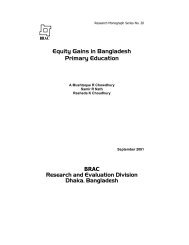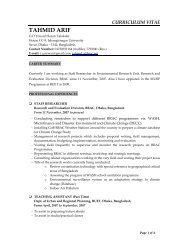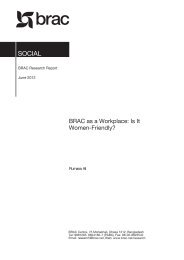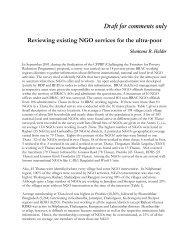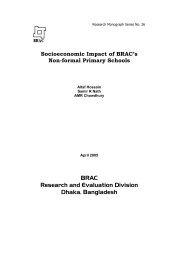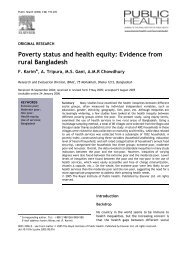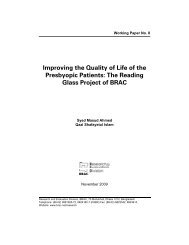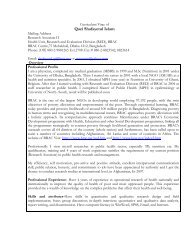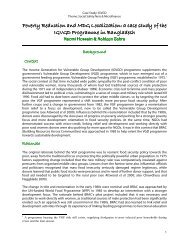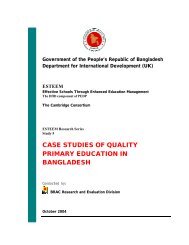State of Justice in Chittagong Hill Tracts - BRAC Research and ...
State of Justice in Chittagong Hill Tracts - BRAC Research and ...
State of Justice in Chittagong Hill Tracts - BRAC Research and ...
You also want an ePaper? Increase the reach of your titles
YUMPU automatically turns print PDFs into web optimized ePapers that Google loves.
Bangladesh. They acted as District Magistrates with jurisdiction to civil <strong>and</strong> crim<strong>in</strong>almatters.The Headmen are responsible for resource management, l<strong>and</strong> <strong>and</strong> revenueadm<strong>in</strong>istration, ma<strong>in</strong>tenance <strong>of</strong> law <strong>and</strong> order <strong>and</strong> adm<strong>in</strong>istration <strong>of</strong> traditional justice<strong>in</strong> the mauza circle. The Headmen <strong>in</strong> turn are assisted by Karbaris or village heads,particularly <strong>in</strong> ma<strong>in</strong>ta<strong>in</strong><strong>in</strong>g law <strong>and</strong> order <strong>and</strong> dispens<strong>in</strong>g traditional justice. The Chiefsare empowered to regulate the acts <strong>of</strong> the Headmen <strong>and</strong> acted as an appellatecourt. Moreover, a recent study (Focus: Asia Report to the UN Parliament Forum onIndigenous Issues 2007) reveals that the overall justice system <strong>in</strong> Bangladesh isseriously dysfunctional, its services to the general population are worsen<strong>in</strong>g <strong>and</strong>access for <strong>in</strong>digenous peoples is particularly limited. Most <strong>in</strong>terventions seek<strong>in</strong>g toenhance access to justice have been <strong>in</strong>adequate <strong>and</strong> largely <strong>in</strong>sensitive to culturaldist<strong>in</strong>ctiveness, further marg<strong>in</strong>aliz<strong>in</strong>g the rights <strong>of</strong> <strong>in</strong>digenous peoples. However, thisparticular scenario discourages the <strong>in</strong>digenous people to seek justice <strong>in</strong> court <strong>and</strong>eventually discourage the <strong>in</strong>digenous people <strong>in</strong> seek<strong>in</strong>g justice.CHT has its own dist<strong>in</strong>ctive feature <strong>in</strong> justice sector. This area is not with<strong>in</strong> thedoma<strong>in</strong> <strong>of</strong> usual rules <strong>of</strong> Bangladesh. The justice system <strong>of</strong> CHT possesses thedist<strong>in</strong>guished characteristic- the existence <strong>of</strong> dual justice system, one is the formalone with<strong>in</strong> the laws <strong>of</strong> the country <strong>and</strong> another is the customs <strong>and</strong> rituals <strong>of</strong><strong>in</strong>digenous people. Except <strong>in</strong> some areas, the whole adm<strong>in</strong>istration is on the h<strong>and</strong> <strong>of</strong>Bengali people. In parallel, the <strong>in</strong>digenous people have their own system. ‘It is thejuxtaposition <strong>of</strong> two which marks the peculiarity <strong>of</strong> <strong>Hill</strong> <strong>Tracts</strong>’ (Bessaignet 1958).Unlike other parts <strong>of</strong> Bangladesh, no crim<strong>in</strong>al court was established <strong>in</strong> CHT till 01July 2008 <strong>and</strong> the civil matters used to be dealt by Deputy Commissioner. In oneh<strong>and</strong>, Deputy Commissioners <strong>of</strong> three districts <strong>and</strong> Divisional Commissioners <strong>of</strong> CHTresolve the dispute <strong>of</strong> civil <strong>and</strong> crim<strong>in</strong>al natures follow<strong>in</strong>g the laws <strong>of</strong> Bangladesh (until01 July 2008), on the other h<strong>and</strong> the stakeholders <strong>of</strong> traditional dispute resolutions <strong>of</strong>CHT resolve the disputes apply<strong>in</strong>g their unwritten customary laws.It would be mentionable that a strong contradiction might be observed between theformal justice system 2 <strong>and</strong> the <strong>in</strong>digenous <strong>in</strong>formal justice system 3 which is stronglyassociated with culture, basically based upon socio-cultural heritage <strong>of</strong> <strong>in</strong>formaljustice practices with<strong>in</strong> communities rather than the legacy <strong>of</strong> formal laws. For this<strong>in</strong>stance an <strong>in</strong>-depth underst<strong>and</strong><strong>in</strong>g <strong>of</strong> <strong>in</strong>digenous <strong>in</strong>formal justice <strong>in</strong>stitutions shouldbe depicted to perceive the forms <strong>and</strong> nature <strong>of</strong> customary justice seek<strong>in</strong>g process,<strong>and</strong> the problems associated with <strong>in</strong>formal as well as formal justice <strong>in</strong>stitutions.Moreover, <strong>in</strong> reality, studies on dispute resolution mechanism <strong>and</strong> the role <strong>of</strong> the<strong>in</strong>stitutions has been neglected. Very few or no research works has been <strong>in</strong>itiated tounderst<strong>and</strong> the dynamics <strong>of</strong> justice system <strong>in</strong> CHT. In this ground, this paper should2In this study, formal justice <strong>in</strong>stitutions/system <strong>in</strong>dicates formal regular judiciary system that follows theConstitution <strong>and</strong> laws <strong>of</strong> Bangladesh <strong>in</strong>cludes upper <strong>and</strong> lower court.3Informal justice system <strong>in</strong>dicates the customary justice system <strong>of</strong> the Pahari groups practiced by Chiefs,Headman <strong>and</strong> Karbari also recognized by CHT regulation act <strong>of</strong> 1900 <strong>and</strong> further amendments <strong>and</strong> alsoby the CHT peace accord <strong>of</strong> 1997.4



